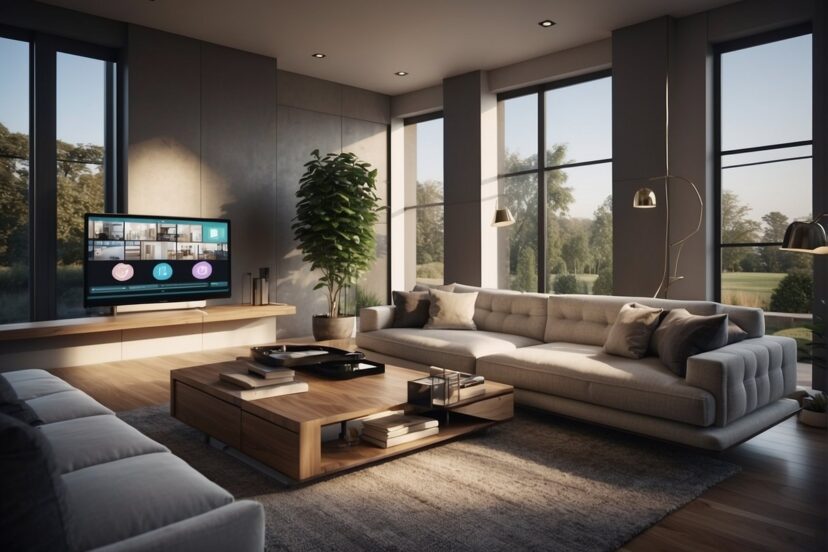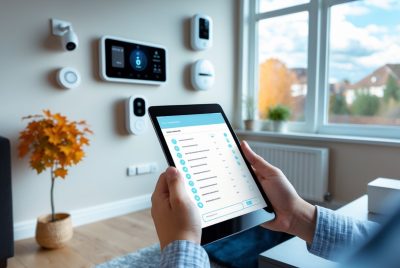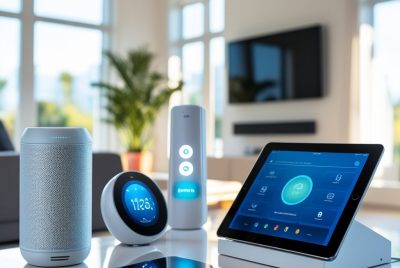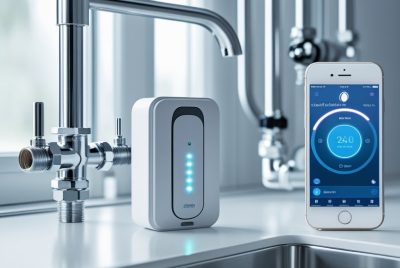Best Smart Home System: The Ultimate Guide
*We may earn a commission for purchases made using our links. Please see our disclosure to learn more.
Best Smart Home System: The Ultimate Guide for Seamless Integration
In today’s interconnected world, the concept of a smart home has evolved from a luxury into a convenient and efficient way to manage daily tasks. As an enthusiast who has spent considerable time analyzing and engaging with the latest technologies, I’ve seen first-hand how smart home systems have become the central nervous system of modern living spaces. These systems offer unparalleled automation, allowing residents to control various aspects of their home environment—from lighting and heating to security—with ease and precision.

The landscape of smart home devices is diverse, with options catering to every need and budget. The increasing prevalence of voice assistants and intuitive apps has made controlling these devices more seamless than ever. This integration is pivotal in creating a responsive environment that simplifies routine tasks, providing comfort and convenience at the touch of a button or the sound of your voice.
With a keen eye on security, I have noticed that home security systems have become more sophisticated and accessible, entwining with smart home systems to ensure safety and peace of mind. These advanced security solutions can include automated alerts, remote monitoring, and integration with other smart devices, combining to create a fortress-like ambiance that doesn’t sacrifice the homely feel we all cherish. As we explore the various options available in 2024, it is clear that the selection of a smart home system is pivotal in modernizing one’s living experience.
Overview of Smart Home Systems

In this section, I’ll provide a clear understanding of the key components that define smart home systems, touching on their features and the overall ecosystem.
Key Features of Smart Homes
The core attributes of smart home systems revolve around automation, remote control, and interconnectivity. These systems encompass smart devices that can communicate with one another, typically through a central hub or controller. Aspects like voice control have become synonymous with smart homes, enabling users to command their devices by just speaking. Compatibility between various devices and brands is crucial; it ensures a seamless operation where devices like lights, thermostats, and security cameras can work in harmony. The ability to connect through wired or wireless means, including Wi-Fi, Bluetooth, and sometimes cellular networks, ensures the connectivity necessary for these systems to function effectively.
Understanding the Smart Home Ecosystem
An effective smart home ecosystem is not just a collection of gadgets; it’s an integrated network. The foundation lies within smart hubs and controllers that act as the brain of the operation, enabling different devices to communicate. These ecosystems can include products from Amazon Alexa, Google Assistant, Apple HomeKit, and Samsung SmartThings, which offer various levels of integration. Users should prioritize ecosystems that support a wide range of products while ensuring the system they choose aligns with their existing devices and future requirements.
Choosing the Right Smart Home Platform

In choosing the ideal smart home platform, it’s crucial to consider the ecosystem’s compatibility with your current devices and your personal preferences regarding digital assistants.
Comparing Amazon, Google, and Apple Solutions
Amazon, Google, and Apple offer comprehensive smart home ecosystems supported by their respective digital assistants – Alexa, Google Assistant, and Siri. Here’s a brief comparison to help you decide:
- Amazon Alexa: Alexa is highly versatile, with extensive third-party device support. Users heavily invested in Amazon services might find it appealing, given its seamless integration with Amazon shopping and entertainment features.
- Google Home (Google Assistant): For those who prioritize services like Google Calendar and enjoy using Android devices, Google Home is an excellent match. Integration with Google’s ecosystem is its strong suit, ensuring a unified experience across devices.
- Apple HomeKit (Siri): Apple’s HomeKit is ideal for users who prioritize privacy and are deeply entrenched in the Apple ecosystem. It offers stringent security features but is often considered less flexible due to its limited compatibility with non-Apple products.
Exploring Open Protocols like Zigbee and Z-Wave
Beyond the big brands, open protocols such as Zigbee and Z-Wave play a significant role in smart home connectivity:
- Zigbee: Zigbee is a globally recognized open standard that ensures reliable, low-power, wireless mesh networking for smart home devices. It’s compatible with a variety of smart home products and is known for good interoperability.
- Z-Wave: Operating on a low-frequency radio, Z-Wave is another mesh network protocol designed for smart home automation. It’s known for its robust operation, having minimal interference, and supporting over 2,000 certified devices for extensive compatibility.
These protocols are particularly important with the advent of Matter, the new industry-standard aimed at increasing interoperability between smart home products, which further emphasizes the importance of choosing a platform that supports these protocols.
Core Components of Smart Home Systems

In detailing the core components of smart home systems, I’ll focus on the critical elements that anchor any efficient and responsive smart home setup.
The Heart: Smart Hubs and Controllers
Smart hubs and controllers act as the central nervous system of a smart home, enabling the interconnectivity and control of different devices. Hubs are the central points that facilitate communication between devices, often using protocols like Zigbee, Z-Wave, or Wi-Fi. Voice assistants like Amazon Alexa, Google Assistant, or Apple HomeKit serve as controllers and can be integral to the hub, providing a seamless way to manage the smart home ecosystem with voice commands.
Smart lock and security cameras are devices heavily reliant on the responsiveness of these hubs. For instance, a smart lock can receive commands to secure a door remotely while a hub can allow integration of security cameras into a broader security system. Some hubs come with built-in cameras, adding a layer of functionality.
Essential Devices for a Smart Home Setup
An optimal smart home setup involves a suite of essential devices that work together to provide convenience and security. High on the list are:
- Smart Locks: Keyless entry and remote access control,
- Security Cameras: Real-time surveillance and recorded footage,
- Voice Assistants: Hands-free control and automation,
- Smart Thermostats: Energy-efficient temperature control,
- Smart Light Bulbs: Adjustable lighting and scheduling.
Each of these devices relies on the hub for integration into the broader system, allowing for automated routines—for example, a smart thermostat adjusting the temperature automatically when the smart lock signals that the home is unoccupied. Similarly, voice assistants can control smart light bulbs to simulate presence or enhance security.
Integration and Automation

In my experience, the essence of modern smart home systems lies in their integration capabilities and the extent of automation they facilitate. Effective integration binds various devices into a cohesive unit, while advanced automation enables these systems to adapt to user behaviors and preferences, ensuring a harmonious and intelligent living environment.
Creating Seamless Smart Home Routines
Creating seamless smart home routines is all about using platforms like IFTTT (If This Then That), which I find invaluable for linking disparate smart devices and services. By establishing “applets,” I can set conditional statements that trigger specific actions. For example, IFTTT allows me to create protocols such as: If I leave my home, then automatically turn off my smart lights and lower my thermostat. To illustrate:
- Voice Commands: “Alexa, I’m leaving.”
- Turns off lights
- Adjusts thermostat
- Activates security system
- Mobile App Actions: Tap “Away Mode” to:
- Drop down blinds
- Switch on garden lights at dusk
Enhancing Home Security with Smart Technology
I take my home security seriously, and incorporating smart technology has indeed raised the bar. Automations are especially critical here, as they can instantaneously react to potential security breaches. For instance, a routine could be set up to:
- When: Front door camera detects motion between 12 AM and 5 AM
- Send an instant alert to my mobile app
- Trigger floodlights
- Start recording video footage
Within the home automation system, utilizing voice commands and mobile device management lends both convenience and an added layer of security, since I can remotely monitor and control my home’s safety parameters.
Advanced Features and Trends

In my examination of the latest smart home systems, it’s become clear that the current trends are heavily focused on energy efficiency and the integration of voice control with home appliances and entertainment systems. Here are some of the key advancements in these areas:
Energy Saving and Sustainable Living
I’ve noted that smart home devices are increasingly incorporating features aimed at reducing energy consumption. For example:
- Smart Thermostats: Devices like the Ecobee Smart Thermostat Premium are designed to learn my schedule and adjust heating and cooling for optimum energy savings without compromising my comfort.
- LED Lighting Solutions: Many smart lighting systems now use LED bulbs, which consume significantly less energy than traditional bulbs. They can be programmed to dim or turn off automatically when not needed, further conserving energy.
- Smart Air Purifiers: These devices can monitor air quality and adjust settings automatically, ensuring they only use as much power as needed to maintain a clean indoor environment.
Voice-Enabled Appliances and Entertainment Systems
Voice control has become a staple in the smart home space, making interaction with my devices more natural and convenient:
- Smart Speakers: I use voice commands to control various smart home devices via smart speakers, which act as central hubs for home automation.
- High-Resolution Smart Displays: Smart displays with high-resolution screens offer crisp visuals and can be controlled by voice, enhancing my interaction with smart home functions and online content.
- Eero Built-In: With Wi-Fi systems like Eero now including native voice control through smart speakers, I can manage my network settings just by speaking aloud.
Overall, these advancements make smart home systems not just a matter of convenience but also an ally in leading a more energy-conscious and efficient lifestyle.
Setting Up and Maintaining Your Smart Home
In my experience, the key to a successful smart home lies in meticulous setup and proactive maintenance. It’s about choosing a system that’s reliable, provides value, and is affordable over the long term.
Installation Best Practices
Choose Your Ecosystem: I start by selecting a smart home ecosystem that ensures compatibility and ease of expansion. Google Home, Amazon Alexa, and Apple HomeKit are popular choices. Affordability and future-proofing are important considerations.
- Reliable Network: A robust Wi-Fi network is essential. I make sure to position my router centrally and consider a mesh network for larger homes to avoid dead spots that can hinder device performance.
- Strategic Device Placement: Smart devices should be placed where they’re most needed to save money and energy. For example, smart thermostats should go in commonly used areas, not near windows or drafty spots.
- Battery Backup: I plan for power outages by choosing devices with battery backup and maintaining those batteries, ensuring that critical systems remain online.
Ongoing Management and Troubleshooting
Regular Updates: To maintain my smart home’s reliability, I regularly update device software to patch vulnerabilities and improve performance. This is usually a simple process, often automated within the ecosystem’s app.
- Unified Control: A central app or dashboard is invaluable. It allows me to monitor and control different devices seamlessly, which in my opinion is essential for maintaining a responsive and efficient smart home.
- Routine Maintenance: Regular inspections help me catch issues early. I check battery levels, clear device caches, and reboot periodically to prevent glitches.
- Effective Troubleshooting: When issues arise, I start with the basics – checking connections and power sources. If a device is unresponsive, a reset often does the trick. Detailed error logs within the smart home’s app can guide me to a solution.
By adhering to these practices, I ensure my smart home system is not only set up for optimum performance but also primed for smooth operation and minimal disruption.
Frequently Asked Questions
In this guide, I’ll address some of the most common inquiries about setting up a smart home system. Tapping into my own expertise and reliable sources, I aim to provide clear and actionable advice to help you navigate the world of smart home technology.
1. How do I choose the right smart home system for my needs?
Choosing the right smart home system hinges on what devices you plan to use and what ecosystem you prefer. For instance, if you’re intent on using a Nest thermostat, Google Home would be a fitting choice as it’s designed to integrate seamlessly with Nest products.
2. Which smart home devices are essential for a beginner’s setup?
For those just starting out, I recommend a reliable smart speaker such as the Amazon Echo or Google Nest Mini, smart bulbs like those from Sengled for easy lighting control, and a smart thermostat to efficiently manage your home’s temperature.
3. Can you recommend smart home solutions that are compatible with Apple products?
For those deeply invested in the Apple ecosystem, Apple HomeKit provides a secure and cohesive platform to manage compatible smart devices. You can control them using Siri, create automation routines, and ensure a high level of privacy and security.
4. What are the top smart home platforms currently available in the market?
Amazon Alexa and Google Home are two frontrunners, offering extensive device compatibility, regular updates, and sophisticated voice assistant capabilities. Both platforms offer robust functionality for managing a wide array of smart home devices.
5. What are the most sought-after smart home brands offered by retailers?
Popular smart home brands include the likes of Amazon with their Echo devices, Google with their Nest products, and Apple’s HomeKit-compatible devices. Users favor Sonos for its high-quality smart speaker systems that integrate seamlessly into various smart home environments.




